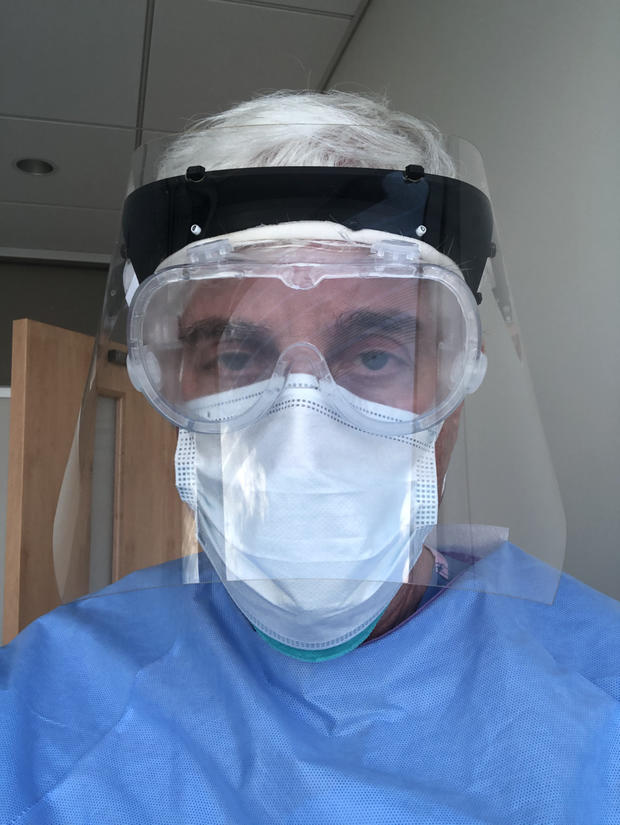Since I’m a practicing physician at NYU Langone Health, today was my turn to get the Pfizer vaccine against SARS-CoV-2, the virus that causes COVID-19.
In addition to seeing patients in my office, I perform procedures as a gastroenterologist that can potentially expose me to aerosolized virus.
This was me last April on the COVID wards, stunned by the devastation.
Now I’m stunned — and thrilled — that vaccines have been developed in less than a year. I know some people have been put off by the term Operation Warp Speed because of fears that vaccines are being developed too quickly. But the record time from publication of the genetic sequence of SARS-CoV-2 to the beginning of Phase 1 safety trials was accomplished because of decades of previous research developing so-called “vaccine platforms.”
On December 15, I interviewed National Institutes of Health director Dr. Francis Collins, and he gave me an easy-to-understand analogy for these platforms. Imagine there’s a factory making some kind of a widget. “You figure out how to make widgets really well, and then you can change the design a little bit, and you can make a different widget, but really fast, because you already have the assembly line there. It’s kind of what we’re doing with these vaccine platforms.”
While vaccines against COVID are being developed in record time, this hasn’t been so much a sudden leap as a gradual decrease in the time we need to develop a vaccine.
According to the National Institutes of Health, back in 2003, it took 20 months from the selection of a genetic sequence for the SARS virus circulating back then until the first human injection of a vaccine. With H5N1 (bird flu) in 2006, that time was shortened to 11 months. H1N1 (swine flu) took 4 months, Zika, 3.25 months. With the Moderna vaccine against COVID-19, the SARS-CoV-2 sequence was posted January 10th, National Institute of Allergy and Infectious Diseases (NIAID) and Moderna started work January 11th, manufacturing began January 14th, and the Phase 1 trial began March 16th, 2020 — only about two months after the viral sequence was known. What a scientific tour de force!
Operation Warp Speed began May 15th, and has helped speed up the testing of vaccine candidates by cutting red tape, but public health officials I trust, including Dr. Anthony Fauci, have assured me no corners were cut. I’ve reviewed the data presented in the public FDA advisory committee meetings that reviewed the Emergency Use Authorization requests for the Pfizer and Moderna vaccines, and I agree with the FDA’s decision that, based on the current scientific evidence available, the benefits of these vaccines far outweigh the risks. Pfizer’s vaccine was authorized for individuals 16 and older, Moderna’s for those 18 years and older.
Researchers are looking into some serious allergic reactions that have occurred in about 1 in 45,000 people so far who have received the Pfizer vaccine, and they will be looking out for any other unexpected side effects in the future. It’s too early to know the exact incidence of these reactions. This morning, I reached out to Dr. Fauci for insight into the allergic reactions, and he texted me this: “One of my divisions here at NIAID is planning a study to explore all this — incidence, mechanisms, etc.”
For me, the benefit of being protected far outweighs the highly unlikely risk of a serious side effect.
Getting the vaccine felt exactly the same to me as getting a flu shot. I felt a little pinch, and am still feeling fine two hours later. No big deal.
What I felt most was a mixture of emotions — all good. I was caught by surprise by tearing up as I started to describe how I was feeling for our CBS News camera. I guess the weight of all these months — taking care of patients, trying to keep myself, my loved ones, my friends, and so many others safe, coupled with the tension-filled job of reporting on the pandemic — caught up with me.
I felt a flood of relief, though I know it will still be a challenge to get enough of the population immunized to achieve herd immunity. I felt gratitude that vaccines are becoming available less than a year after we recognized there was a novel coronavirus.
And I felt amazement at the scientific accomplishment. I know logically about the decades of research that led to my being immunized. I understand how a tiny piece of genetic code — messenger RNA — stashed away inside a protective lipid nanoparticle creates immunity to SARS-CoV-2 by tricking the immune system into thinking it’s being attacked by the virus. But there’s also a part of me that looks at this astounding achievement as pure magic.


